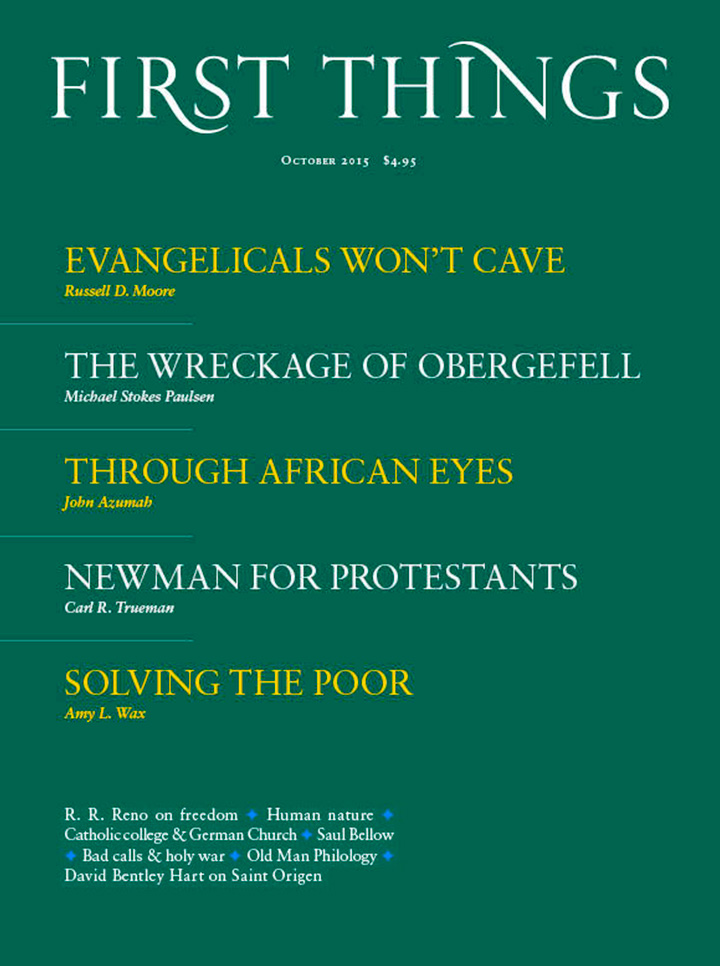
Our Kids:
The American Dream in Crisis
by robert d. putnam
simon & schuster, 400 pages, $28
In a recent article in the New York Review of Books on the television and stage adaptations of Hilary Mantel’s historical novels Wolf Hall and Bring up the Bodies, the Irish critic Fintan O’Toole tries to explain the present popularity of a story about Henry VIII’s obscure aide-de-camp, Thomas Cromwell. According to O’Toole, viewers identify Cromwell as a “middle-class man trying to get by in an oligarchic world.” Like those viewers, Cromwell realizes that the “bourgeois orthodoxies” that were “once considered the ticket to success”—“hard work, self-discipline, domestic respectability, . . . the steady accumulation of money, and a valuing of stability”—no longer provide an escape from “the power of entrenched privilege.”
Robert Putnam, in his new sweeping tour of America’s social landscape, echoes O’Toole’s indictment. Putnam’s book combines ethnographic anecdote and a compendium of social science data to create a compelling portrait of America’s widening class divide and growing working-class distress. Although he avoids talk of bourgeois values in favor of bland academic parlance, his message comes through: For those not born to privilege, the goals of self-improvement and even a safe, stable life are increasingly out of reach. Individuals of so-called lower socioeconomic status are trapped in their current state of declining fortunes. Choices, values, and behavior are beside the point. What matters are the larger forces hemming them in: the barriers, conditions, trends, structures, and lack of resources.
Putnam opens the volume with his 1959 high school class in Port Clinton, Ohio, a thriving, hard-working, civically vibrant group. Almost all were raised in hopeful, well-socialized, orderly two-parent families, and most went on to higher education and good jobs. The contrast with the Port Clinton of today is stark. Residents tend to fall into two camps: those without a college degree (many of whom work only erratically and barely get by) and well-off college graduates.
Separated geographically and by social distance, and rarely intermingling in neighborhoods, church, or school, these groups no longer share common mores or a civic life. The affluent educated have largely held on to conventional habits. Their families are intact and well organized, and they work hard and steadily. They maintain ties to community organizations and religious institutions. For the rest of the population, the traditional mainstays have dissolved. Families are chaotic and fatherless, crime and drugs rampant, employment elusive, and religious, civic, and political apathy rife.
In his remaining chapters, Putnam shows that Port Clinton stands in for the country’s direction as a whole. With a focus on the well-being of children, he marshals the numbers on families, parenting, schooling, and community. The pages are peppered with vivid charts, tracing trend lines by class that diverge like a pair of shears. Over the past several decades, the prosperous and educated have thrived, with parents in this group spending ever more time and money on the “concerted cultivation” of their children, who increasingly go on to college and well-paying careers. In contrast, the lives of those at the bottom have steadily deteriorated, with children suffering the consequences.
The result is a widening gap between these groups and their offspring on a range of social indicators. While single-parent families have remained at low levels for the educated, they have exploded for high school graduates. Divorce ticked up for everyone in the 1970s, but leveled off for the affluent while continuing to rise for the rest of the population. Family dinners—a predictor of good outcomes for children—diminished for everyone starting in the 1970s, but steadied at high levels only for the educated. Educational achievement sagged uniformly, but the upper class arrested that decline and recovered. Social trust and civic involvement fell during this period, but have continued to fall dramatically to low levels for non-college graduates.
In focusing on why inequality has increased—the topic to which he devotes the most attention—Putnam cooks up a stew of culprits, forces, and factors without any systematic attempt to determine their relative influence and importance. His data is simple and correlational. He doesn’t even do the hard work of regressions and controls, of quantitatively comparing families’ or individuals’ present resources and standards of living to those available in the past. Nor does he scrutinize the literature for such comparisons. The overall picture is haphazard, and the analysis feels lazy and superficial.
This lack of rigor allows Putnam to embrace the favored explanation that now dominates academia and the equality-obsessed media: It’s the economy, stupid. Although Putnam leavens his account with some clear-eyed concessions (including periodic warnings that correlation is not causation), and dutifully lists “cultural change” as one “factor” in recent developments, he doesn’t hesitate to apportion blame. “Economic hardship,” and “not the cultural turmoil of the 1960s,” is the “most important precursor” of the breakdown of the family in the lower half of society.
In stressing the monetary and material roots of working-class collapse, Putnam relies chiefly on the observation that real earnings for male high school graduates and dropouts have stagnated or declined since the 1970s, with secure factory jobs dwindling. Yet he ignores significant fluctuations during the past fifty years, and fails to explain why social cohesion, and especially family structure, has deteriorated relentlessly despite significant economic ups and downs. Putnam himself states that the thirty-year drop in real earnings for male high school graduates has been only 11 percent without explaining how this alone can account for the accelerating pathologies that he recounts.
And although Putnam admits that life for the working class, and even the poor, used to be dramatically different, he has remarkably little to say about why parents in straitened circumstances were once far more effective in establishing orderly homes, socializing their children, and equipping them to exploit chances for self-improvement or, at least, to achieve a decent, satisfying life. And he devotes no attention to the significant number of less skilled Americans—including many recent immigrants—who effectively resist the social problems that bedevil others at the bottom of the economic ladder.
In fact, Putnam’s own anecdotes belie his tilt toward the economic roots of working-class distress, highlighting the dynamic, two-way relationship between material hardship and life choices. Joe, one of his working-class protagonists, is steadily employed at a decent job managing a pizza franchise. Yet he chronically overspends his earnings and forms tempestuous, unstable liaisons that produce children he can scarcely afford. Indeed, virtually all of Putnam’s working-class subjects seem to specialize in a familiar litany of self-defeating behaviors. Short-lived broken relationships, random spawning and abandonment of children, squandered educational opportunities, repetitive lawbreaking, and drug abuse are staples of their existence. Male incarceration is commonplace. Parenting is often harsh while also indifferent, erratic, and neglectful.
In short, the picture Putnam paints is too often that of people who repeatedly pass up the chance to steady or improve their own lives. The sociologist Isabel Sawhill, whom Putnam cites, has observed that a few simple choices—the so-called “success sequence”—can minimize poverty even for people with modest education and skills. The prescription is to graduate from high school, work steadily at any job available, get married before having children, and avoid crime. These basic prudential steps are within the reach of virtually everyone, regardless of means and background, and most people used to accept them as indispensable way stations to responsible adulthood. Yet these steps are no longer followed by most people without a college degree. Laying this at the feet of economic causes requires adopting a peculiar brand of causal materialism that now dominates the social sciences.
Putnam does not discuss Charles Murray’s Coming Apart. In that book, Murray considers many of the same trends Putnam reports, although with a narrower focus on white Americans. But Murray is far more thoughtful about the cultural origins of working-class spiritual malaise. The problem is one of demoralization—in two senses. The demoralizing of social life, with roots in the 1960s, has left the less educated psychologically demoralized. Elite disdain for organizing conventions surrounding sexuality, respectability, manhood, faith, and the nobility of work has discouraged and disoriented non-elites, weakening their resistance to the depredations of vice. Murray issues a clarion call for cultural renewal, asking the upper classes to preach what they practice.
Putnam will have none of this. He says remarkably little about the relationship of elite culture to working-class anomie. And the concept of “respectability,” which is so central to Murray’s analysis, barely appears. Putnam’s emphasis on the monetary and material culminates in a final chapter, “What Is to Be Done?,” that effectively throws in the towel on family breakdown. Well-designed policies supposedly can make up for the family’s collapse and set young people on the right course. Putnam recommends beefed-up tax credits, monetary transfers, benefits programs, better-trained and better-paid teachers, vocational education and apprenticeships, community college aid, widely available preschools, and free after-school sports programs. These lavishly funded initiatives will enable teachers and bureaucrats to substitute for parents from birth to adulthood, returning us to a previous idyll of mobility and equality. There is nothing really new here, and Putnam’s exposition seems half-hearted, as if he doesn’t really believe this laundry list will do the trick, even with renewed effort and much more money.
There’s also a call for a massive mentoring program for lower-class children, with the well-educated acting as surrogate parents and advisors on a wide scale. The goal is to socialize poor children to upper-class norms, thereby equipping them to attend and get through college. Putnam’s mentoring idea is a variant of the pet elite project of college-for-all, which looks to education as the force of salvation and rescues working-class children by transforming them into upper-class kids.
This pie-in-the-sky dream reflects the deep logic of our post-1960s world, which offers the good life to the knowledge class, but lacks any approved or positive vision for others. On this view, careerism, “creativity,” consumerism, lifestyle cultivation, expressive individualism, and sexual adventure are fulfilling and prestigious, while civility, duty, ordinary work, and fealty to conventional social roles are exploitative and oppressive. Given this outlook, college for all makes perfect sense and anything else looks unjust.
In fact, the project is unrealistic and thus ultimately pernicious. Not everyone is able to join the knowledge elite, nor does everyone want to. Our society will always need basic low-skilled labor, from serving meals to caring for dependents to cleaning toilets. The working class cannot be phased out or made to disappear. Economic improvement for workers is an important goal, although difficult to achieve. But it cannot be enough. What is needed is a viable and vibrant culture that maintains the meaning of working-class life and recognizes its dignity. On this, Putnam has virtually nothing to say and little to offer.

